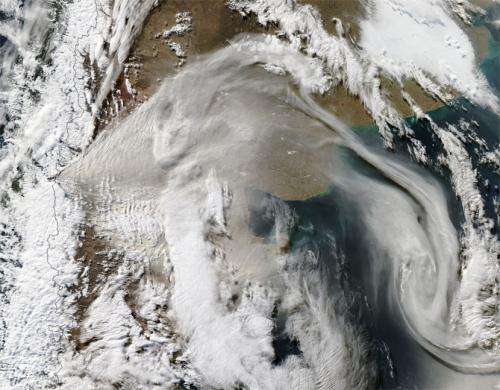NASA provides a two-satellite view and video of the Chilean volcano eruption

NASA's Aqua satellite and the GOES-13 satellite both captured their own unique views of the eruption of the Puyehue-Cordón Caulle volcano in Chile this week. One satellite provided a high-resolution image of the ash plume while the other provided a video showing the plumes movement over several days.
NASA's GOES Project released a satellite animation of the Puyehue-Cordón Caulle volcano that shows the movement of the ash plume over several days. The NASA GOES Project, located at NASA's Goddard Space Flight Center, Greenbelt, Md. created the animation from images obtained by the Geostationary Operational Environmental Satellite, GOES-13. The GOES series of satellites are operated by NOAA.
The GOES-13 animation includes visible and infrared imagery from GOES-13 that runs from June 4 at 1745 UTC (1:45 p.m. EDT) to June 6 at 1445 UTC (10:45 a.m. EDT). On June 4, the plume was blowing to the southeast. Through June 5 and 6, the winds shifted and viewers of the animation can see the plume start turning in a counterclockwise motion to the east, northeast and then north as high pressure moves in (In the south high pressure system winds rotate opposite they way they do in the northern hemisphere, so they shifted the winds from southeast to the north.
A visible image was taken on June 8 at 18:30 UTC (2:30 p.m. EDT) by the Moderate Resolution Imaging Spectroradiometer (MODIS) instrument that flies aboard NASA's Aqua satellite. The plume from the Puyehue-Cordón Caulle volcano in Chile has now expanded to the south and is now covering a much wider angle than earlier this week. The image shows the plume of ash now blowing to the east over Argentina in what almost appears to be a 90 degree triangle.
The MODIS Rapid Response Team is also located at NASA Goddard, and creates images from the MODIS instrument that flies aboard NASA's Aqua and Terra satellites.
According to MSNBC on June 8, flights in and out of Chile, Argentina and Buenos Aires, Brazil were suspended or delayed over the last several days and travelers should check with their airlines. The Associated Press and CBS News noted that the organization in Chile that monitors volcanic eruptions: the National Geology and Mines Service considers the eruption moderate so far, but it could change.
Meanwhile, satellite data from NASA and NOAA will help airlines determine the direction of the ash plumes and whether air travel can resume.
Provided by NASA's Goddard Space Flight Center





















